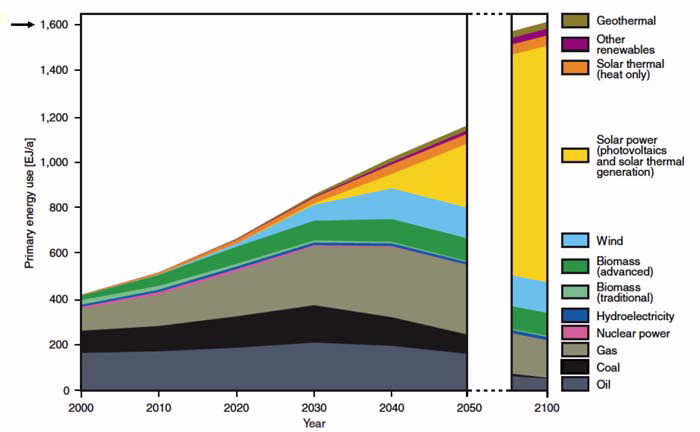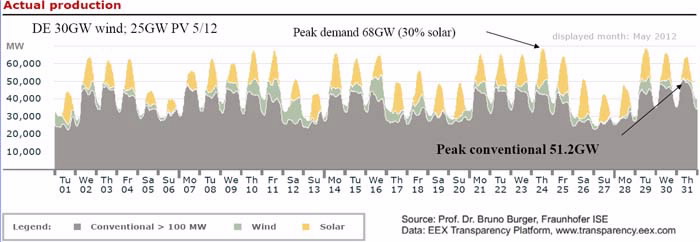Global demand for devices powered by the sun will overtake fossil fuels by the middle of the century, says world's leading expert on solar energy.
 |
Figures produced by the German Advisory Council on Global Change (WBGU) 2003. |
Imagine cars that are powered by the sun by the millions, or the lighting of an entire freeway, or your mobile device using solar energy. These things may be here sooner than you think, and in mass production, according to the man behind the world's most energy efficient solar panels.
Professor Martin Green from the University of New South Wales was sharing his insights on the future of solar energy at a science lecture hosted by ANSTO and believes the industry will be a dominant player by 2020 before eclipsing fossil fuels by the end of the century.
He is a man who knows what he’s talking about. Professor Green initiated the Solar Photovoltaics Group at the university in 1974 and through his research helped elevate the solar panel industry in the 1980s from obscurity with the production of the world's first 20 per cent energy efficient silicon cell in 1985.
This was something that at the time was considered the equivalent of being the first person to run the 4 minute mile.
The now renamed School of Photovoltaic and Renewable Energy Engineering, of which Green is the Executive Research Director, currently holds the world record for the highest energy conversion efficiency for a silicon solar cell at 25 per cent.
Green says Germany is the precedent for what we can expect on a global scale as industry moves to the use of photovoltaics, which is slowly becoming a cheaper method of generating electrical power by converting solar radiation into direct current electricity.
"The brown band (referring to a powerpoint presentation) shows the range of electricity prices that are associated with the electricity group network, so the top of that range is what you would pay for the retail price for electricity if you were a private household, and the bottom of the range is the wholesale price outputting from a large coal fired power station.
 |
| Peak conventional energy use versus solar power in Germany May 2012 |
"Very interestingly, photovoltaics are beginning to penetrate that region and can now compete with the retail price in many areas of the world and there's a possibility they will become one of the cheapest ways of generating electricity by 2020."
In recent years, half of the current photovoltaic capacity has gone into Germany who have been quick to adopt alternate energy sources. The uptake was helped by generous feed-in tariffs promoting the use of solar power and wind.
As of early 2012, feed-in tariffs ranged from 3.4 ct/kWh for hydropower facilities over 50 MW to 24.43 ct/kWh for solar installations on buildings up to 30 kW.
The aim is to meet Germany’s renewable energy goals of 12.5 per cent of electricity consumption in 2010 and 35 per cent in 2020.
Figures showing the use of electricity in the month of May this year demonstrate how effective Government subsidies have been and also the reliability of solar as an alternate energy source.
With peak demands of over 60 gigawatts, solar provided close to 30 per cent of the required demand across Germany. While electricity demand across the country varies, the figures demonstrate peak usage during the day, which Professor Green says is a good match for when solar is available.
"What this demonstrates is that solar is very predictable." he said.
Professor Green believes Germany is setting an example the rest of the world will soon follow, including Australia.
"I think a lot of the world will look like this by 2020. So across Europe a lot of countries will implement solar and perhaps even Australia."
Solar panels are made from silicon compounds that are able to store radiation absorbed from the sun and turn it into reusable energy. The major application for silicon was in the microelectronics industry, but since 2007, Professor Green says the game has changed and the solar energy has started to take over, in terms of production.
This crossover has been helped by government subsidies, but also what Professor Green believes were technological innovations in the sector that has brought down the production costs for the material.
"Evolution over time has seen the blocks [of silicon] get bigger and as they get bigger they become cheaper."
An entire industry has now developed that is able to scale-up production of this core material in solar cells and sell at a profit.
The future of solar energy efficiency
Since the 1980s when the biggest improvements were made in producing 25 per cent energy efficient solar cells, there has been little further growth. This has limited solar cells use as a real alternative to fossil fuels, but Professor Green expects that to change dramatically in coming years.
"If you look at what efficiencies you can gain from converting sunlight into electricity you should be able to get to around 74 per cent efficiency, so in principle much higher efficiencies are possible than what we’re currently seeing from silicon cells.
"There’s been a number of methods suggested to get use from a single cell efficiency of 30 per cent to this 74 per cent. The best approached attempted is when you stack cells made of different materials on top of each other.
“So if you stack a material with a wide band gap or high energy response threshold to the incoming light, it can absorb the high energy photons from the light and pass the remaining energy through to the next cell that will be transparent to the lower energies.
"What you get is a filtering system within the layers that are each better matched to the different energy levels."
Professor Green's science talk was part of ANSTO's monthly Distinguished Lecture series where experts in the fields of science and technology from around the world discuss the latest trends and predict where we are heading in the future.
Published: 17/10/2012


